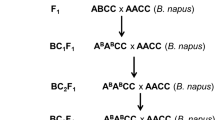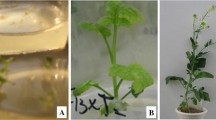Summary
Complete resistance to Leptosphaeria maculans, the cause of blackleg of oilseed rape (Brassica napus), was transferred from B. juncea to B. napus through an interspecific cross. B. juncea-type complete resistance (JR) was recognized first in one F3 progeny (OnapJR) by the absence of leaf-lesions on seedlings and canker-free adult plants. The commercially important characters of B. napus were retained in advanced lines of OnapJR, which combined JR with low erucic acid levels (<0.5%), high seed yield and variable maturity dates.
JR appeared to be inherited as a major gene or genes. Segregation for resistance and susceptibility contintied to occur during later generations of selection of OnapJR. JR was readily transferred from OnapJR to other suitable B. napus cultivars or lines with partial resistance to blackleg and resulted in highly vigorous carly generation selections adapted to cold, wet situations along with complete resistance to blackleg.
Similar content being viewed by others
References
Cargeeg L. A. & N. Thurling, 1979. Seedling and adult plant resistance to blackleg (Leptosphaeria maculans (Desm.) Ces et de Not.) in spring rape (Brassica napus L.) Aust. J. Agric. Res. 30: 37–46.
Hayes J. D., 1973. Prospects for controlling cereal disease by breeding for increased levels of resistance. Ann. Appl. Biol. 75: 140–144.
McGee D. C. & G. A. Petrie, 1979. Seasonal patterns of ascospore discharge by Leptosphaeria maculans in relation to black leg of oilseed rape. Phytopathology 69: 586–589.
Nelson R. R., 1978. Genetics of horizontal resistance to plant diseases. Ann. Rev. Phytopathol. 16: 359–360.
Rajan S. W. & M. W. Hardas, 1964. Autosyndetic and allosyndetic pairing in Brassicae. Ind. J. Genet. and Pl. Breeding 24: 15–21.
Roy N. N. & J. Reeves, 1975. Breeding better rape and linseed for Western Australia. J. Agric. Western Australia. 16: 95–97.
Roy N. N., 1978a. A study on disease variation in the population of an interspecific cross of Brassica juncea L. x B. napus, L. Euphytica 27: 145–149.
Roy N. N., 1978b. Wesreo—a blackleg resistant rapeseed. J. Agric. Western Australia. 19: 42.
Roy N. N., 1980. Species crossability and early generation plant fertility in interspecific crosses of Brassica. SABRAO J. 12: 43–54.
Roy, N. N. & M. L. Poole, 1981. Wesroona and Wesbell-high rainfall rapeseed varieties. Western Australian Department of Agriculture-Farmnote No. 109/81.
Roy, N. N., 1983. Transfer of Brassica juncea type complete resistance to blackleg into Brassica napus. Proc. Australian Plant Breeding Conf. Adelaide, p. 239–240.
Russel, G. E., 1978. Plant breeding for pest and disease resistance. Butterworth and Co. Ltd.
Van der Plank J. E., 1971. Proc. Seminar on Horizontal resistance to the blast disease of rice CIAT, Cali-Columbia. 21–26.
Author information
Authors and Affiliations
Rights and permissions
About this article
Cite this article
Roy, N.N. Interspecific transfer of Brassica juncea-type high blackleg resistance to Brassica napus . Euphytica 33, 295–303 (1984). https://doi.org/10.1007/BF00021125
Received:
Issue Date:
DOI: https://doi.org/10.1007/BF00021125




